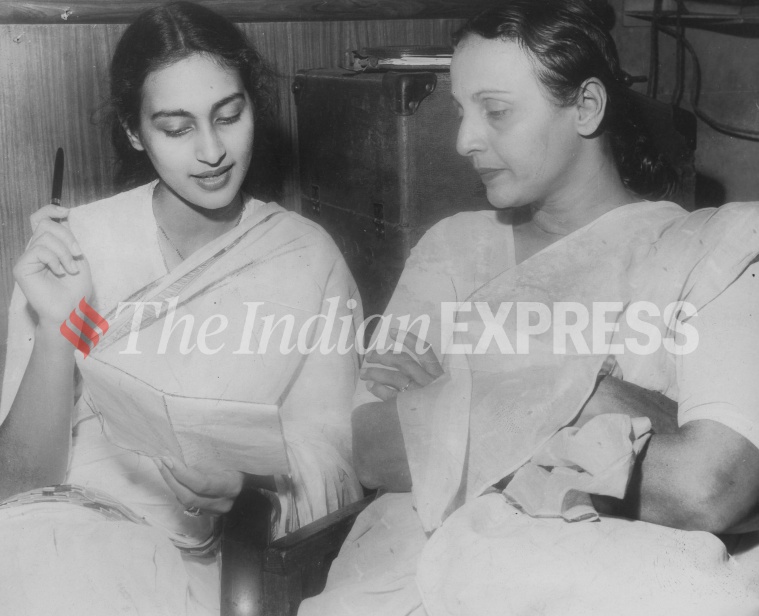Click here to follow Screen Digital on YouTube and stay updated with the latest from the world of cinema.
Nutan: The star who changed the narrative around the career of a married actress
Before the likes of Kareena Kapoor Khan, Deepika Padukone and Alia Bhatt, it was Nutan who changed the narrative around the career of a married actress. In the 1960s, she defied the age-old belief that an actress' career goes kaput after getting married.
 Nutan was born on June 4, 1936. (Express archive photo)
Nutan was born on June 4, 1936. (Express archive photo) It’s almost impossible to forget how achingly beautiful Nutan was when she began her acting career. She first faced the camera at just 14 for the 1950 film Humari Beti, directed by mother Shobhna Samarth. The actor left an indelible mark on the minds of those who had the fortune of watching her on the silver screen. Before the likes of Kareena Kapoor Khan, Anushka Sharma, Deepika Padukone and Alia Bhatt, it was Nutan who changed the narrative around the career of a married actress. In the 1960s, she defied the age-old belief that an actress’ career goes kaput after getting married. She won four of her five Filmfare Awards after marriage and the birth of her son Mohnish Bahl.
For today’s generation, who is oblivious to legendary Nutan’s contribution to Indian cinema, a mere glance at her in the song “Chor Do Anachal” from Paying Guest (1957) would be enough to introduce you to her craft. The song showcases how the actor emoted through her eyes and barely needed dialogues to express herself. You can’t help but smile as the song plays – partially due to the music itself and then due to Nutan’s simplistic, yet charming, presence on the screen.
Once you find out that Nutan headlined films like Bimal Roy’s Bandini and Sujata, both timeless classics, it would be hard to believe that it was difficult for the young actor to find a footing in the film industry in the initial years of her career. In one of her earlier interviews, Nutan had shared, “I was terribly thin and within the industry, there was a joke that if you want to draw Nutan, just draw a straight line. My mother even feared that perhaps I had tuberculosis. So, at 17, despite the fact that I had so many film offers, my mother sent me to a finishing school in Switzerland.”
Nutan’s mother Shobna Samarth called her back from Switzerland as she was being swamped with offers, one of which was from filmmaker K Asif for the role of Anarkali, which she declined. Hence, began Nutan’s career at 18. She portrayed multi-layered characters in Seema (1955), Sujata (1959) and Bandini (1963) with as much finesse as she played her part in light-hearted romantic comedies like Tere Ghar Ke Samne (1963), Paying Guest (1957), Anari (1959) and Dil Hi Toh Hai (1963). Her expansive filmography mirrors her thought, “An actor should strive for variety, that’s all. Because that will ensure their growth.”
Besides being an actor, Nutan had a penchant for direction as she believed, “The film is a director’s medium.” She directed her sister Tanuja’s debut film Chhabili but never got credited for it. “Nutan was great in direction and editing, vo naam mera tha par direct ki thi Nutan ne (though I was credited as the director, Nutan directed it), vo sab mein hi achi thi (she was good in everything),” Shobhana Samarth had once revealed about Chhabili.
Her passion for films not only floored film critics of the time, but the international magazine Forbes also included Nutan’s performance in Bandini in its list of ’25 Greatest Acting Performances of Indian Cinema’, a decade after her death. It noted, “Nutan’s genius lay in portraying a whole range of emotions without resorting to over-the-top histrionics.” Her co-actors too spoke highly of her. Dev Anand once said, “Nutan was one of the few actresses with whom one could have an intelligent conversation.”
 Nutan was as simplistic off the screen as on it. (Express Archive photo)
Nutan was as simplistic off the screen as on it. (Express Archive photo)
Nutan was as simplistic off the screen as on it. Her mother, Shobhna, during a 1958 interview with The Washington Post, said about her daughter, “She is the wisest, sweetest child, but I have got to keep reminding her that she’s a film star. She gets so fed up with dressing up on the set that when she gets home, she is happy in the oldest things she can find, and wears no make-up — not even lipstick.”
The actor par excellence understood at a very early stage of her career how the Indian film industry and audience look at its female stars. “In Indian films, marriage and a career just don’t work out. Audiences don’t like their heroines to be married…” she told The Washington Post.
Yet, Nutan achieved a fine balance between her professional and personal life. On October 11, 1959, she married naval Lieutenant-Commander Rajnish Bahl, and her career flourished along with her personal life. Filmmakers also never stopped coming to her with meaningful roles. In fact, Bandini, one of her ‘favourite’ roles, happened after she gave birth to son Mohnish Bahl (who went on to become an actor). The credit for her long-standing career goes to her husband, who told her after marriage, “If you were a painter or a writer, I wouldn’t have asked you to stop your work and I won’t, although you are an actress. Continue, by all means. But do fewer films, choose your roles.”
 Nutan and mother Shobhna Samarth on the set of Chhabili. (Express archive photo)
Nutan and mother Shobhna Samarth on the set of Chhabili. (Express archive photo)
Though Nutan managed to be a great actor, wife and mother, all at once, she became “distant” from her mother and siblings after marriage. In fact, her relationship with her mother Shobhna went sour for twenty years due to a legal battle over the mishandling of funds. Her younger sister Tanuja stood by their mother and fought with Nutan. In fact, Shobhna had once revealed that the two sisters were never close. “Both were poles apart, temperamentally. One was an introvert and the other an extrovert,” she said in one of her interviews. However, Mohnish had once shared that neither his grandmother nor his mother and aunt Tanuja let their differences affect him and his cousins Kajol and Tanisha. Nutan and Shobhna also mended their relationship in 1983.
However, the mother-daughter duo could only spend little time together. Nutan was diagnosed with breast cancer in 1990, and she passed away at 54 in February 1991.
Nutan had once said, “Once we get to the age of 25, nobody wants to see us any more.” But if you look at her wide-ranging roles, the élan and exuberance she brought to the screen, you would wish to keep looking at her for eternity. Such was the stature of this timeless beauty.


- 01
- 02
- 03
- 04
- 05
































